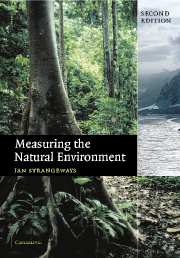Book contents
- Frontmatter
- Contents
- Acknowledgements
- 1 Basics
- 2 Radiation
- 3 Temperature
- 4 Humidity
- 5 Wind
- 6 Barometric pressure
- 7 Evaporation
- 8 Precipitation
- 9 Soil moisture and groundwater
- 10 Rivers and lakes
- 11 Data logging
- 12 Telemetry
- 13 Visibility
- 14 Clouds
- 15 Lightning
- 16 The upper atmosphere
- 17 The oceans
- 18 Cold regions
- 19 Remote sensing
- 20 Atmospheric composition
- 21 Forward look
- Appendix: abbreviations and acronyms
- Index
- References
8 - Precipitation
Published online by Cambridge University Press: 05 July 2014
- Frontmatter
- Contents
- Acknowledgements
- 1 Basics
- 2 Radiation
- 3 Temperature
- 4 Humidity
- 5 Wind
- 6 Barometric pressure
- 7 Evaporation
- 8 Precipitation
- 9 Soil moisture and groundwater
- 10 Rivers and lakes
- 11 Data logging
- 12 Telemetry
- 13 Visibility
- 14 Clouds
- 15 Lightning
- 16 The upper atmosphere
- 17 The oceans
- 18 Cold regions
- 19 Remote sensing
- 20 Atmospheric composition
- 21 Forward look
- Appendix: abbreviations and acronyms
- Index
- References
Summary
After wandering about for some hours, I returned to the landing-place; but, before reaching it, I was overtaken by a tropical storm. I tried to find shelter under a tree which was so thick, that it would never have been penetrated by common English rain: but here, in a couple of minutes, a little torrent flowed down the trunk. It is to this violence of the rain we must attribute the verdure at the bottom of the thickest woods: if the showers were like those of a colder climate, the greater part would be absorbed or evaporated before it reached the ground.
Charles Darwin Voyage of the Beagle (in Brazil)The variable
A history of raingauging
The first written reference to rainfall measurement was made by Kautilya in India in his book Arthasastra in the fourth century BC (Shamasastry 1915). The next reference comes from the first century AD in The Mishnah, which records 400 years of Jewish cultural and religious activities in Palestine (Danby 1933). But neither the Indian nor Palestinian measurements continued for long. They were just isolated events, doomed to be ignored and discontinued. There were to be no more quantitative hydrological or meteorological measurements for another 1000 years — a period in which scholars believed, or were forced to believe, that one turned to the sacred scriptures for answers to questions such as ‘Where do springs arise from?’.
- Type
- Chapter
- Information
- Measuring the Natural Environment , pp. 134 - 177Publisher: Cambridge University PressPrint publication year: 2003



